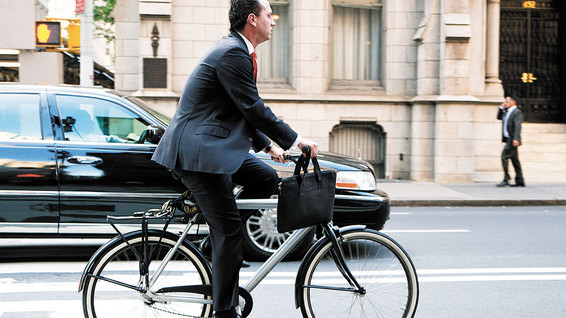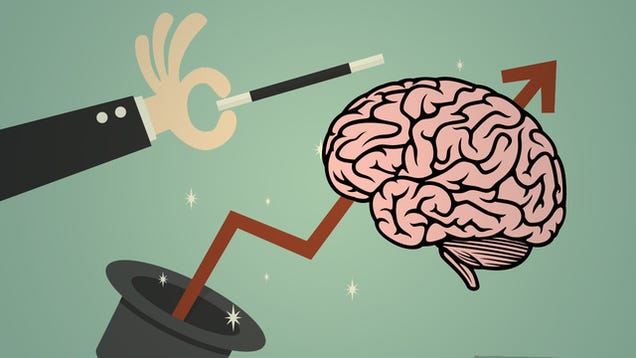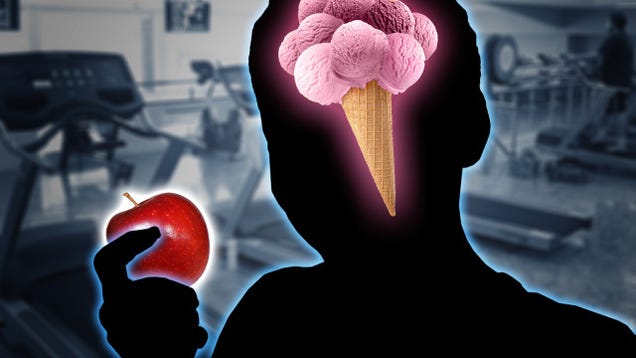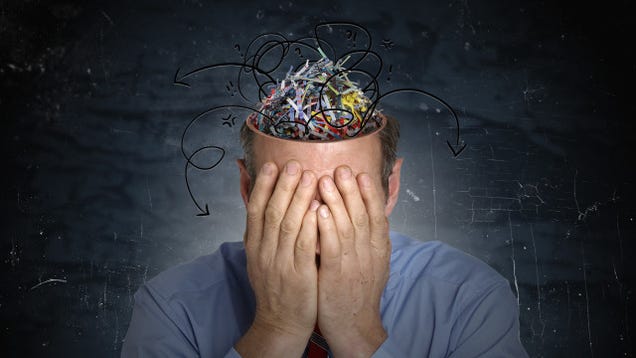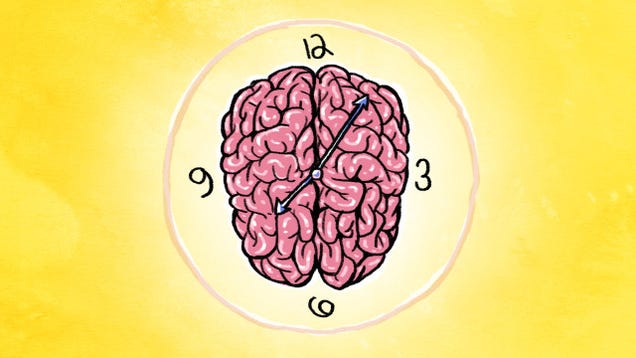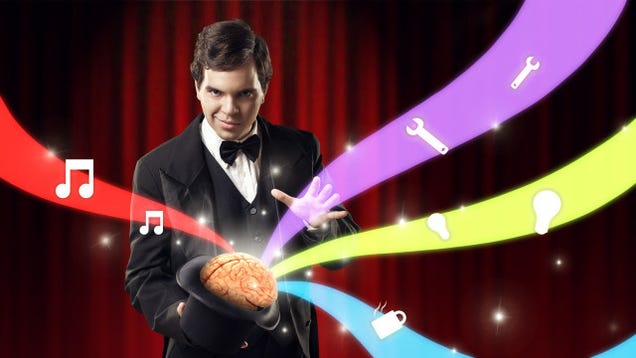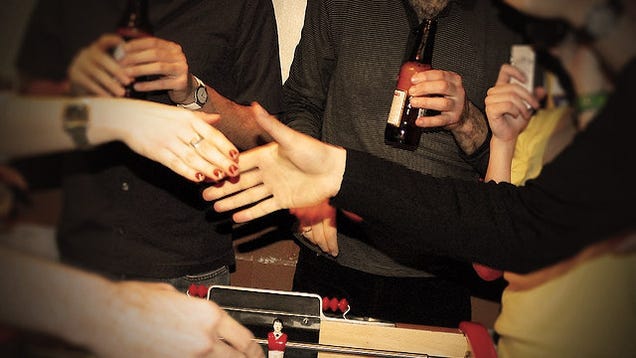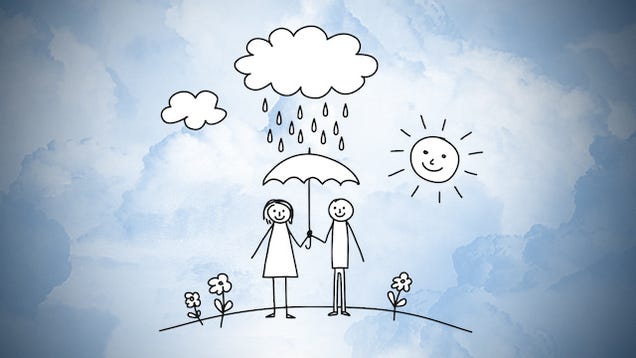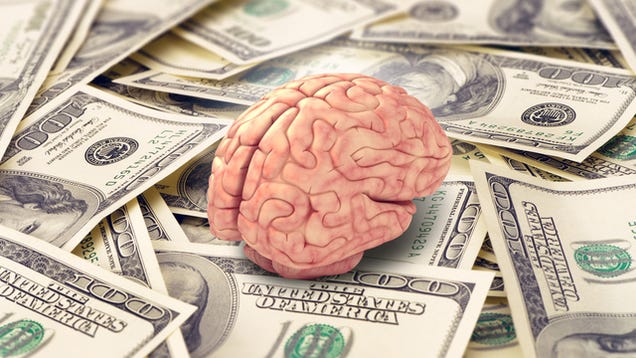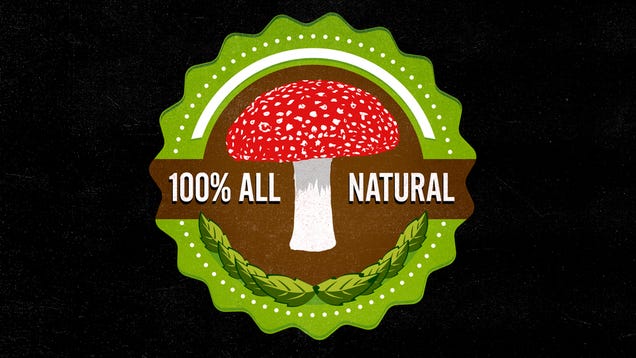
Here’s the thing about nature: It will fuck up your shit. A few weeks ago, the website The Naked Label published a picture of a vibrant, colorful mushroom. It was captioned with a quotation from author and paleo diet advocate Diane Sanfilippo: “We cannot make food better than nature.” The problem? The mushroom pictured was the Amanita muscaria, which is highly poisonous. 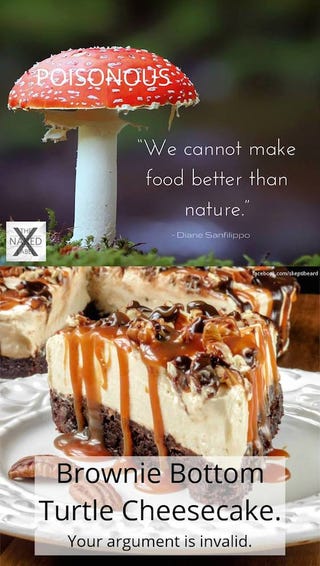
The Naked Label probably wasn’t recommending poisonous mushrooms as a part of your balanced cannabis-induced munchies on purpose. However, this tiny meme is symptomatic of a bigger problem on the internet: self-declared “natural health” gurus who say everything natural is automatically better. It’s not. Are chemical additives safe or should you eat an “all-natural” diet? Is there a reason for the chemical paranoia brought on by Dr. Oz-endorsed mommy-bloggers, or is this just fear mongering from people who need to go back to chemistry class? Is the vision of “nature” propagated by Whole Foods and the like just another marketing term? Recently, several large companies have made decisions to alter their products based on chemical phobia. Is this a good thing? If you follow any “natural” food blogs, you might say yes. But the science says otherwise. And stuck in the middle trying to make sense of it all is the consumer. What the hell does “natural” mean anyway when it’s on a food label? Let’s examine a few recent food kerfuffles to figure out what Nature, Inc. offers the consumer. Kraft Macaroni and Cheese: Still Awful Last month I wrote about Vani Hari, AKA the Food Babe. I decreed that her tactics and statements about food were devoid of science (fine, she’s full of shit). One of her attention-grabbing schemes was petitioning Kraft to remove artificial dyes from their macaroni and cheese. Shortly after my article made her cry tears of blood about her life decisions, Kraft announced that they would be removing the artificial dyes, although they claimed that they started reformulating the recipe a year before she launched her campaign. Whether or not this was a response to her petition, did the change make the product healthier? To start with, let’s remember that we’re talking about a product with powdered cheese. If you were looking for health food, you took a wrong turn three aisles ago after the spinach. We’re also not removing something that causes foodborne illness and replacing it with hummingbird whispers. We’re switching food dyes synthesized in the laboratory to food dyes that are… well, still going to be produced in the laboratory. We now have the safest class of food dyes ever on the market (here’s some reading on the short history of food dye regulation in America). Laboratories have helped that process because they can check final products for safety and purity, whether synthetic or derived from natural sources. And no matter what the source of the dye, a chemical solvent is used to extract the target color molecule. A common tactic of the Food Babe is to tell you these solvents are toxic only in products she’s deemed evil. Paprika is one of the sources for Kraft’s new and improved mac and cheese, and just like in the processes used for some synthetic dyes, hexane is used in processing (when consumed in large quantities, hexane is metabolized into a neurotoxic chemical). Note, with both classes of dyes, you are not consuming hexane, but then again, the Food Babe isn’t known for facts. As for the safety of the synthetic dyes, any substance has drawbacks and they’re about equal in synthetic and natural dyes. Some parents who previously bought the product for their fussy eaters are complaining about the new paprika-based dye. Even though it’s all natural, you can have allergies to paprika. This isn’t the only natural dye with this issue; carmine dye derived from the cochineal insect, sometimes used to punch up the red color in strawberry milkshakes, can induce anaphylactic shock. But it is natural. Raw Milk Will Make You Sick One sacred cow of the natural food movement is raw milk. And why not, all the natural hipsters know that organic kool aid is so five minutes ago and they’ve switched to suckling the raw teet. All my favorite bullshit peddlers—Mercola, Modern Alternative Mama, and Weston Price—endorse raw milk. Even the Food Babe buys into it, saying that “raw dairy is the best choice,” and that “raw dairy products are “alive.” Scary. They say that raw milk maintains milk’s natural enzymes and vitamins, that it even has components to fight off bacteria itself because of the goodness of its wonderful “naturaliness” (my version of truthiness). But when natural advocates endorse going back to a time before we introduced a technological advancement, they often fail to remind the consumer why we made those advancements in the first place. Pasteurization, the process of heating milk to a high temperature for a very small amount of time, kills a vast majority of the bacteria in it and keeps it safe for a longer period of time. Before the process became widespread in the early 20th century, milk was safe for maybe the day after you purchased it, and old milk was a source of festering disease. There are a lot of myths about what pasteurization does to milk that have been floated by the natural health movement. But let’s lay those rumors to rest: It does not induce allergies or lactose intolerance. If you can’t tolerate pasteurized milk, you’re not going to be able to tolerate raw milk either. And as for all those “enzymes” that allegedly die off when Big Dairy is reaching around into your wallet, relax. Your stomach acid will destroy them anyway. All the macronutrients and micronutrients in your pasteurized milk are exactly the same as raw milk. But is raw milk safe? You might think so, but you’d be misled. According to the CDC, less than 1% of milk consumed in the United States is raw milk. From 1993-2006, 121 outbreaks (causing 4,413 illnesses and three deaths) were caused that could be linked back to dairy. Seventy-three of the outbreaks were from raw milk and 48 were from pasteurized milk. Given that less than 1% of the dairy in the country is raw, if it’s safe, why is it causing a majority of the illnesses? The simple answer? It’s not safe, and the people promoting it are not promoting healthy food. They’re promoting the natural epidemic at any cost. Aspartame Won’t Kill You or Make You Fat Recently, Pepsi announced that they were going to remove aspartame from from Diet Pepsi and replace it with sucralose and acesulfame potassium, AKA Ace K. Sucralose is derived from sugar, and Ace K is the sweetener used in Coke Zero that gives it that “real sugar” flavor. Internet-based fears about aspartame are sweeping. Quacks and conspiracy theorists say it’s the most dangerous substance in food, that it causes MS like symptoms and, my personal favorite, that it killed Heath Ledger. So with all these fears, was removing aspartame from Diet Pepsi necessary for safety or health? Science says no. Aspartame is one of the most-studied food additives ever. It’s been shown, time after time, to be safe. No links to cancer, MS, ADHD, the NY Yankees, premature ejaculation, your dog sniffing the litter box, or any other random thing you want to blame on this. It just tastes sweet. It’s not even making you fat. I’m sure you’ve heard that diet soda with aspartame can cause weight gain. I drank Diet Coke when I was overweight, I drank Diet Coke all through my 90lb-weight loss, and I still drink Diet Coke. The difference is that I eat a lot more fruits and vegetables now and fewer french fries. An excess of calories will make you gain weight, not carbonated water with caffeine. Studies linking diet soda to weight gain are, at best, corollary, and haven’t closely enough examined the other behaviors of the people in the study. And speaking of my favorite soda, Coca-Cola offers multiple sugar-free varieties of cola for their customers with different types of sweeteners, and they all taste a little different. Pepsi’s decision to change the sweetener due to a small decline in sales will change the flavor that 95% of their loyal customers enjoyed. It only serves the people with overblown fears of a safe product. Given that aspartame is safe, why not just offer a second option like their competition did? That doesn’t make as good of a press release from Nature, Inc. Paleo: Not Good for Babies Pete Evans is a former pizza chef from Australia. Now he’s trying to harm your children. Evans became a celebrity chef due to his popular and flavorful pizza offerings. But then he discovered the Paleo lifestyle, or the annoying-everyone-you-know diet. The Paleo diet alleges to be a natural diet, one that closely mimics what our primal ancestors ate. Paleo devotees say that many diseases in society came along with the “unnatural” introduction of modern agriculture. Under this line of reasoning, Paleoites believe all foods that came with agriculture should be removed from your diet for optimal health. So when Evans, the man who made a fortune as a celebrity pizza chef, found Paleo, he began advocating the removal of grains, dairy, and other whole food groups from your life in order to find health. So if it’s so healthy, why was Evans’ new cookbook, Bubba Yum Yum: The Paleo Way, pulled before publishing over concerns that the recommendations would harm a baby? In attempt to be more natural than store-bought formulas, Evans’ bone-broth based baby formula recipe could have potentially starved a baby. Despite the recipe’s overwhelming naturaliness, it lacked calories, something tiny humans very much need to thrive. Furthermore, the liver pate recipe for infants contained such high levels of vitamin A that it could have caused toxic side effects. The unfortunate part of this is that well-meaning parents with every intention of feeding their children healthy foods easily would have bought this thinking they were doing the right thing for their kids. Parents, whether you choose breast milk or formula, please consult your pediatrician or a registered dietitian. Just like you wouldn’t consult your local Dominos pizza guy on what to feed your baby, Pete Evans the pizza chef is also not an expert. Non-GMO Chipotle Will Still Make You Need to Use Chipotlaway Burrito giant Chipotle announced last week that they ditched the GMOs from their menu. Amid random pictures on the internet of fish being spliced into tomatoes, reports from people who have never worked in food regulation about no-GMO regulation, and questions from mommy-bloggers-cum-doctors about GMOs causing health problems, did Chipotle act in the best interest of the public? Not. Even. Close. Chipotle claims that GMOs increase pesticide use and that the long-term health impact of their consumption are unknown. However, the claims just don’t stack up. We also have decades of data showing that GMOs are safe for consumption and the environment. In a large-scale analysis of all the studies done of GMOs, data showed that they reduced chemical pesticide use by 37% and increased crop production by 22%. Farmers can spend less and use a lower amount of safer types of pesticides. In fact, by switching to non-GMO ingredients, Chipotle is knowingly endorsing the use of more toxic pesticides and a fairly hazardous production method in the name of avoiding the GMO title. As Stephan Neidenbach wrote at We Love GMOs and Vaccines: BASF used a process known as mutagenesis to breed their sunflowers. Their seeds were doused with ethyl methanesulfonate and sodium azide to alter their DNA.[8] Ethyl mathanesulfonate is a possibly carcinogenic compound that produces random mutations in DNA.[9] Sodim azide is an extremely toxic compound used as a biocide and in airbag systems. It is lethal to humans at only 0.7 grams.[10] (...)The one conclusion that we can draw is that Chipotle is not doing this for any reason other than to profit off of the current GMO paranoia. Additionally, it’s incredibly disingenuous for Chipotle to claim that they’re only using non-GMO ingredients. The meat they serve still comes from animals that eat GMO feed. To switch to non-GMO feed would make their prices skyrocket and drastically hurt their business. As was demonstrated by this marketing stunt, their commitment to “food with integrity” comes right after their commitment to shareholders. Promoting fresh, natural thousand-calorie burritos with integrity gets harder if the price goes up to $16. Panera’s Publicity Ploy On the heels of the Chipotle decision, not to be outdone, Panera announced that they were tired of serving poison to their customers and would be removing approximately ⅓ of their ingredients from their recipes. This list of ingredients they’re removing includes caffeine, components of vanilla, and artificial sweeteners. According to Nature, Inc., this means their menu, from their 1,110-calorie sandwich to their 700-calorie caffeinated milkshakes, is suddenly a beacon of health. Unless they’re getting rid of the coffee and soda, claiming they’re removing caffeine from the menu is total bullshit. Remember, everything is made of chemicals, even your cup of “make-me-not-hate-life” in the morning. And if they do get rid of the option to add Splenda to the coffee, I’m heading back to Starbucks for a “toxic” PSL, thanks. The reasoning behind the retooling is publicity. Ron Shaich, Panera’s CEO, claims his “kids are eating Panera 10 to 11 times a week,” and he doesn’t want them to eat “junk.” Whenever a decision like this comes out, you should take an enormous pause to consider what it says about the ingredients the establishment was serving before. How much did Shaich care about his company’s food previously if he’s calling it junk now? Is this just a new way of greenwashing a thousand-calorie sandwich? Was Shaich not aware of the incredibly strict regulations involved in getting food additives to market? Didn’t anyone tell him that chefs and food scientists, who his company chose to hire, worked to make those exact flavors for their company that he’s now publicly deemed “junk?” (Those latter two questions are rhetorical.) And as for Shaich’s kids eating Panera ten times a week, I offer this suggestion: locate a grocery store. Maybe buy some goddamn apples. The Difference Between Nature, Inc. and Nature What is natural, anyway? And what’s the difference between slapping “natural” on a label versus… getting food from nature? We drive hybrid cars, own designer dogs that have been inbred from the grey wolf down to the chihuahua, and live in temperature-controlled, eco-friendly environments. We load the hybrid dog into the hybrid car, stretch on a pair of green-friendly $100 lululemons while hiking in the artificially designed nature trails of L.A. while drinking artificially sanitized water and tweeting selfies on our technological marvel iPhones with the hashtag #nature. That’s Nature Inc™. Nature, on the other hand, is generations ravaged by smallpox because vaccines weren’t invented yet. It’s having a home birth not because it’s been romanticized, but because it’s your only option. It’s dying of malnutrition because, even though you have soil, sunlight and water, you don’t have the technology to fight off bugs, weeds, or droughts. Nature is one too many sunburns leading to melanoma. Nature is when shows like Naked and Afraid and Born In The Wild are just life, and not documentary-worthy expenditures of bored and privileged twenty-somethings who can call the hospital when something goes horribly wrong. Because as much as nature makes delicious fruits and vegetables, if you’re not paying attention, it also makes poisonous mushrooms.
Yvette d’Entremont holds bachelor’s degrees in theatre and chemistry and a master’s degree in forensic science. With a background working as an analytical chemist, she now runs SciBabe.com full time. She’s currently working on her first novel, SciBabe’s Ten Rules To BS Detection, due out in winter 2016. Her site debunks pseudoscience with humor and science. She lives in southern California with her dog, Buddy, and cat, Lexi. Follow her at fb.com/sciencebabe and scibabe.com. Image by Jim Cooke | 















